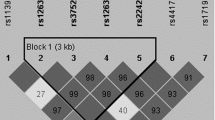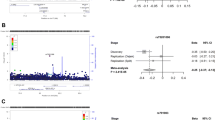Abstract
Autoimmune thyroid disease (AITD) is a recurrent and refractory clinical endocrine disease. Some studies have shown that the incidence of AITD is not only related to iodine, a kind of environmental factor, but that susceptibility genes also play a crucial role in its pathogenesis. Since research on susceptibility genes is still underway, the aims of this study were to assess the association between copy number variations (CNVs) and AITD, to identify genes related to susceptibility to AITD, and to explore the risk factors in the occurrence of AITD. Blood samples from five AITD patients and five controls from each area were assessed by chromosome microarray to identify candidate genes. The copy number (CN) of the candidate genes and urinary iodine levels were determined in adults, including 158 AITD patients and 181 controls, from areas having different iodine statuses. The cell growth-related genes, glypican 5 (GPC5), B9 domain containing 2 (B9D2), and ankyrin repeat and suppressor of cytokine signaling [SOCS] box-containing protein family 11 (ASB11), were selected as the candidate genes. The distribution of GPC5, B9D2, and ASB11 CNVs in AITD patients and controls was significantly different, and high urinary iodine levels and GPC5 CNVs are risk factors for AITD. There was no significant association between urinary iodine level and CNVs of the candidate genes. High urinary iodine levels and GPC5 CNVs are risk factors for AITD, but an association with the occurrence of AITD was not found.

Similar content being viewed by others
References
Cho WK, Jang JP, Choi EJ, Ahn M, Kim SH, Cho KS, Park SH, Baek IC, Jung MH, Kim TG, Suh BK (2017) Association of polymorphisms in toll-like receptors 4 and 9 with autoimmune thyroid disease in Korean pediatric patients. Int J Endocrinol 2017:2304218
Hollowell JG, Staehling NW, Flanders WD, Hannon WH, Gunter EW, Spencer CA, Braverman LE (2002) Serum TSH, T(4), and thyroid antibodies in the United States population (1988 to 1994): National Health and nutrition examination survey (NHANES III). J Clin Endocrinol Metab 87(2):489–499
Jacobson EM, Huber A, Tomer Y (2008) The HLA gene complex in thyroid autoimmunity: from epidemiology to etiology. J Autoimmun 30(1–2):58–62
Schneider H, Downey J, Smith A, Zinselmeyer BH, Rush C, Brewer JM, Wei B, Hogg N, Garside P, Rudd CE (2006) Reversal of the TCR stop signal by CTLA-4. Science 313(5795):1972–1975
Schneider H, Smith X, Liu H, Bismuth G, Rudd CE (2008) CTLA-4 disrupts ZAP70 microcluster formation with reduced T cell/APC dwell times and calcium mobilization. Eur J Immunol 38(1):40–47
Iafrate AJ, Feuk L, Rivera MN, Listewnik ML, Donahoe PK, Qi Y, Scherer SW, Lee C (2004) Detection of large-scale variation in the human genome. Nat Genet 36(9):949–951
Kelley J, Johnson MR, Alarcon GS, Kimberly RP, Edberg JC (2007) Variation in the relative copy number of the TLR7 gene in patients with systemic lupus erythematosus and healthy control subjects. Arthritis Rheum 56(10):3375–3378
Ibáñez P, Bonnet A, Débarges B, Lohmann E, Tison F, Pollak P, Agid Y, Dürr A, Brice A (2004) Causal relation between alpha-synuclein gene duplication and familial Parkinson’s disease. Lancet 364(9440):1169–1171
Zimmermann MB (2009) Iodine deficiency. Endocr Rev 30(4):376–408
Zimmermann MB, Jooste PL, Pandav CS (2008) Iodine-deficiency disorders. Lancet 372(9645):1251–1262
Zama SY, Ahmed M, Vandiraja N (2013) Prevalence of goitre in school children of chamarajanagar district, Karnataka, India. J Clin Diagn Res 7(12):2807–2809
Mitka M (2013) Even mild iodine deficiency during gestation may impair brain function in children. JAMA 309(23):2428
Luo Y, Kawashima A, Ishido Y, Yoshihara A, Oda K, Hiroi N, Ito T, Ishii N, Suzuki K (2014) Iodine excess as an environmental risk factor for autoimmune thyroid disease. Int J Mol Sci 15(7):12895–12912
Yan Y, Zhang Y, Liu L (2006) Method for determination of iodine in urine by As3+-Ce4+ catalytic spectrophotometry. Health Standard of China, Beijing WS/T:107–2006
Zhang L, Zhou Y, Cheng C, Cui H, Cheng L, Kong P, Wang J, Li Y, Chen W, Song B, Wang F, Jia Z, Li L, Li Y, Yang B, Liu J, Shi R, Bi Y, Zhang Y, Wang J, Zhao Z, Hu X, Yang J, Li H, Gao Z, Chen G, Huang X, Yang X, Wan S, Chen C, Li B, Tan Y, Chen L, He M, Xie S, Li X, Zhuang X, Wang M, Xia Z, Luo L, Ma J, Dong B, Zhao J, Song Y, Ou Y, Li E, Xu L, Wang J, Xi Y, Li G, Xu E, Liang J, Yang X, Guo J, Chen X, Zhang Y, Li Q, Liu L, Li Y, Zhang X, Yang H, Lin D, Cheng X, Guo Y, Wang J, Zhan Q, Cui Y (2015) Genomic analyses reveal mutational signatures and frequently altered genes in esophageal squamous cell carcinoma. Am J Hum Genet 96(4):597–611
Bailey JA, Gu Z, Clark RA, Reinert K, Samonte RV, Schwartz S, Adams MD, Myers EW, Li PW, Eichler EE (2002) Recent segmental duplications in the human genome. Science 297(5583):1003–1007
Conrad B, Antonarakis SE (2007) Gene duplication: a drive for phenotypic diversity and cause of human disease. Annu Rev Genomics Hum Genet 8:17–35
Nguyen DQ, Webber C, Ponting CP (2006) Bias of selection on human copy-number variants. PLoS Genet 2(2):e20
Redon R, Ishikawa S, Fitch KR, Feuk L, Perry GH, Andrews TD, Fiegler H, Shapero MH, Carson AR, Chen W, Cho EK, Dallaire S, Freeman JL, Gonzalez JR, Gratacos M, Huang J, Kalaitzopoulos D, Komura D, MacDonald JR, Marshall CR, Mei R, Montgomery L, Nishimura K, Okamura K, Shen F, Somerville MJ, Tchinda J, Valsesia A, Woodwark C, Yang F, Zhang J, Zerjal T, Zhang J, Armengol L, Conrad DF, Estivill X, Tyler-Smith C, Carter NP, Aburatani H, Lee C, Jones KW, Scherer SW, Hurles ME (2006) Global variation in copy number in the human genome. Nature 444(7118):444–454
Matsuse M, Sasaki K, Nishihara E, Minami S, Hayashida C, Kondo H, Suzuki K, Saenko V, Yoshiura K, Mitsutake N, Yamashita S (2012) Copy number alteration and uniparental disomy analysis categorizes Japanese papillary thyroid carcinomas into distinct groups. PLoS One 7(4):e36063
Jia D, Wei L, Guo W, Zha R, Bao M, Chen Z, Zhao Y, Ge C, Zhao F, Chen T, Yao M, Li J, Wang H, Gu J, He X (2011) Genome-wide copy number analyses identified novel cancer genes in hepatocellular carcinoma. Hepatology 54(4):1227–1236
Saadati HR, Wittig M, Helbig I, Hasler R, Anderson CA, Mathew CG, Kupcinskas L, Parkes M, Karlsen TH, Rosenstiel P, Schreiber S, Franke A (2016) Genome-wide rare copy number variation screening in ulcerative colitis identifies potential susceptibility loci. BMC Med Genet 17:26
Voll SL, Boot E, Butcher NJ, Cooper S, Heung T, Chow EW, Silversides CK, Bassett AS (2017) Obesity in adults with 22q11.2 deletion syndrome. Genetics in Medicine: Official Journal of the American College of Medical Genetics 19(2):204–208
Veugelers M, Vermeesch J, Reekmans G, Steinfeld R, Marynen P, David G (1997) Characterization of glypican-5 and chromosomal localization of human GPC5, a new member of the glypican gene family. Genomics 40(1):24–30
Filmus J, Capurro M, Rast J (2008) Glypicans. Genome Biol 9(5):224
Li Y, Yang P (2011) GPC5 gene and its related pathways in lung cancer. Journal of Thoracic Oncology : Official Publication of the International Association for the Study of Lung Cancer 6(1):2–5
Bhattacharjee A, Richards WG, Staunton J, Li C, Monti S, Vasa P, Ladd C, Beheshti J, Bueno R, Gillette M, Loda M, Weber G, Mark EJ, Lander ES, Wong W, Johnson BE, Golub TR, Sugarbaker DJ, Meyerson M (2001) Classification of human lung carcinomas by mRNA expression profiling reveals distinct adenocarcinoma subclasses. Proc Natl Acad Sci USA 98(24):13790–13795
Yu W, Inoue J, Imoto I, Matsuo Y, Karpas A, Inazawa J (2003) GPC5 is a possible target for the 13q31-q32 amplification detected in lymphoma cell lines. Am J Hum Genet 48(6):331–335
Reardon DA, Jenkins JJ, Sublett JE, Burger PC, Kun LK (2000) Multiple genomic alterations including N-myc amplification in a primary large cell medulloblastoma. Pediatr Neurosurg 32(4):187–191
Li F, Shi W, Capurro M, Filmus J (2011) Glypican-5 stimulates rhabdomyosarcoma cell proliferation by activating hedgehog signaling. J Cell Biol 192(4):691–704
Yamada H, Watanabe M, Nanba T, Akamizu T, Iwatani Y (2008) The +869T/C polymorphism in the transforming growth factor-beta1 gene is associated with the severity and intractability of autoimmune thyroid disease. Clin Exp Immunol 151(3):379–382
Gartner R, Schopohl D, Schaefer S, Dugrillon A, Erdmann A, Toda S, Bechtner G (1997) Regulation of transforming growth factor beta 1 messenger ribonucleic acid expression in porcine thyroid follicles in vitro by growth factors, iodine, or delta-iodolactone. Thyroid : Official Journal of the American Thyroid Association 7(4):633–640
Waldmuller S, Freund P, Mauch S, Toder R, Vosberg HP (2002) Low-density DNA microarrays are versatile tools to screen for known mutations in hypertrophic cardiomyopathy. Hum Mutat 19(5):560–569
Sussman MA, Lim HW, Gude N, Taigen T, Olson EN, Robbins J, Colbert MC, Gualberto A, Wieczorek DF, Molkentin JD (1998) Prevention of cardiac hypertrophy in mice by calcineurin inhibition. Science 281(5383):1690–1693
Ferrari SM, Fallahi P, Antonelli A, Benvenga S (2017) Environmental issues in thyroid diseases. Front Endocrinol 8:50
Acknowledgements
We are grateful for the assistance by the Institute for Prevention and Treatment of Endemic Disease of Shanxi Province. And we also thank the colleagues who took part in the survey for their dedication and support.
Authorship
The contribution of each author is as follows: Hongmei Shen and Yunfeng Guan designed the research; Yunfeng Guan, Hongmei Shen, Xing Jin, Yi Pang, Lixiang Liu, Qingzhen Jia, Fangang Meng, and Xiaoye Zhang conducted the research; Yunfeng Guan analyzed the data; Yunfeng Guan wrote the paper; Hongmei Shen had primary responsibility for final content. All the authors read and approved the final manuscript.
Funding
This work was supported by the National Natural Science Foundation of China (Grant No. 81573098).
Author information
Authors and Affiliations
Corresponding author
Ethics declarations
All the procedures used in this experiment were reviewed and approved by the biomedical research ethics committee of Harbin Medical University.
Conflict of Interest
The authors declare that they have no conflicts of interest.
Additional information
Publisher’s Note
Springer Nature remains neutral with regard to jurisdictional claims in published maps and institutional affiliations.
Rights and permissions
About this article
Cite this article
Guan, Y., Liu, L., Jia, Q. et al. The Role of Cell Growth-Related Gene Copy Number Variation in Autoimmune Thyroid Disease. Biol Trace Elem Res 195, 409–416 (2020). https://doi.org/10.1007/s12011-019-01880-7
Received:
Accepted:
Published:
Issue Date:
DOI: https://doi.org/10.1007/s12011-019-01880-7




